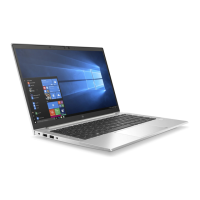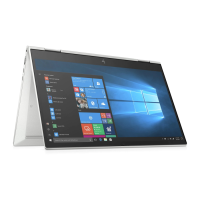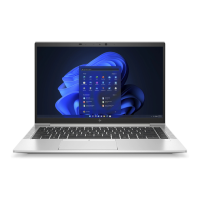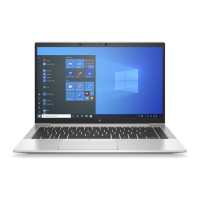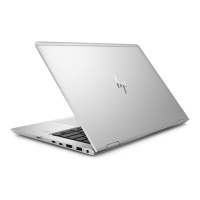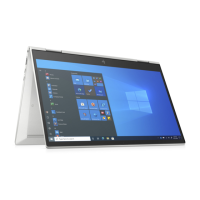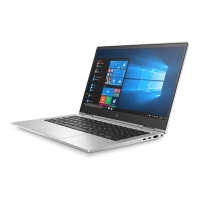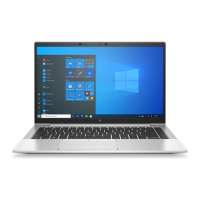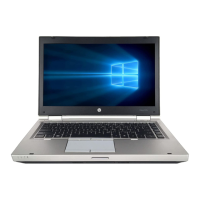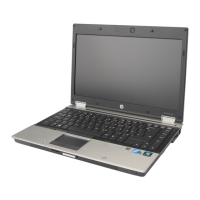Do you have a question about the HP EliteBook 835 G8 and is the answer not in the manual?
Details components located on the right side of the computer, including ports and card readers.
Details components located on the left side of the computer, including ports and security slots.
Identifies components of the display assembly, such as cameras, antennas, and sensors.
Covers keyboard layout, touchpad functionality, special keys, and indicator lights.
Details components on the bottom of the computer and information on service labels.
Provides instructions for inserting and removing nano SIM cards for wireless connectivity.
Lists major computer components and their corresponding spare part numbers for replacement.
Details spare parts for display assembly subcomponents like bezels, cameras, and panels.
Lists the necessary tools for performing component removal and replacement procedures.
Covers essential precautions for disassembly, handling parts, and preventing damage.
Explains ESD risks and precautions to protect electronic components from static damage.
Outlines steps to prepare the computer for component removal and replacement.
Step-by-step guide for removing the computer's bottom cover to access internal components.
Instructions for removing and installing memory modules, including covers and clips.
Details the procedure for removing and replacing the Wireless Local Area Network module.
Guides on how to remove and replace the Wireless Wide Area Network module.
Provides instructions for removing and installing the M.2 solid-state drive.
Step-by-step instructions for removing and replacing the computer's battery.
Procedure for removing and replacing the Real-Time Clock (RTC) battery.
Instructions for removing and replacing the computer speakers.
Details the process for removing and replacing the card reader board.
Procedure for removing and replacing the power connector cable.
Instructions for removing and replacing the USB board.
Guides on how to remove and replace the fingerprint reader board.
Step-by-step instructions for removing and replacing the touchpad.
Procedure for removing and replacing the Near Field Communication (NFC) module.
Instructions for removing and replacing the computer's cooling fan.
Details the process for removing and replacing the heat sink, including thermal material.
Step-by-step guide for removing and replacing the system board.
Instructions for removing and disassembling the display assembly.
Procedure for replacing the keyboard and top cover assembly.
Methods for backing up data and creating recovery media using Windows or HP tools.
Overview of system recovery options, including using HP recovery media or Windows tools.
Instructions on how to modify the boot order in BIOS for recovery media.
Details on using HP Sure Recover for OS recovery and system restoration.
Guide to using the Windows-based utility for diagnosing hardware issues.
Information on using the UEFI-based diagnostic tool for hardware troubleshooting.
Explains how to use and customize remote diagnostics via UEFI settings.
Guide to navigating and configuring BIOS settings for system setup and management.
Instructions for returning BIOS settings to their original factory default values.
Instructions for checking, downloading, and installing BIOS updates for system stability.
Information on configuring Trusted Platform Module (TPM) settings for enhanced security.
Details on HP Sure Start technology for monitoring and restoring BIOS integrity.
Provides technical specifications for the computer, including dimensions, weight, and power.
Lists technical specifications for the computer's display, such as resolution and brightness.
Details specifications for various solid-state drive capacities and performance metrics.
Procedures for restoring nonvolatile memory and BIOS settings to factory defaults.
Explanation of nonvolatile memory types and their usage for troubleshooting.
Answers common questions regarding BIOS settings, UEFI vs. legacy BIOS, and memory.
General power cord requirements applicable to all regions for safe operation.
Specific power cord requirements and agency approvals for different countries.
Guidelines for proper disposal and recycling of batteries according to local regulations.
Details components located on the right side of the computer, including ports and card readers.
Details components located on the left side of the computer, including ports and security slots.
Identifies components of the display assembly, such as cameras, antennas, and sensors.
Covers keyboard layout, touchpad functionality, special keys, and indicator lights.
Details components on the bottom of the computer and information on service labels.
Provides instructions for inserting and removing nano SIM cards for wireless connectivity.
Lists major computer components and their corresponding spare part numbers for replacement.
Details spare parts for display assembly subcomponents like bezels, cameras, and panels.
Lists the necessary tools for performing component removal and replacement procedures.
Covers essential precautions for disassembly, handling parts, and preventing damage.
Explains ESD risks and precautions to protect electronic components from static damage.
Outlines steps to prepare the computer for component removal and replacement.
Step-by-step guide for removing the computer's bottom cover to access internal components.
Instructions for removing and installing memory modules, including covers and clips.
Details the procedure for removing and replacing the Wireless Local Area Network module.
Guides on how to remove and replace the Wireless Wide Area Network module.
Provides instructions for removing and installing the M.2 solid-state drive.
Step-by-step instructions for removing and replacing the computer's battery.
Procedure for removing and replacing the Real-Time Clock (RTC) battery.
Instructions for removing and replacing the computer speakers.
Details the process for removing and replacing the card reader board.
Procedure for removing and replacing the power connector cable.
Instructions for removing and replacing the USB board.
Guides on how to remove and replace the fingerprint reader board.
Step-by-step instructions for removing and replacing the touchpad.
Procedure for removing and replacing the Near Field Communication (NFC) module.
Instructions for removing and replacing the computer's cooling fan.
Details the process for removing and replacing the heat sink, including thermal material.
Step-by-step guide for removing and replacing the system board.
Instructions for removing and disassembling the display assembly.
Procedure for replacing the keyboard and top cover assembly.
Methods for backing up data and creating recovery media using Windows or HP tools.
Overview of system recovery options, including using HP recovery media or Windows tools.
Instructions on how to modify the boot order in BIOS for recovery media.
Details on using HP Sure Recover for OS recovery and system restoration.
Guide to using the Windows-based utility for diagnosing hardware issues.
Information on using the UEFI-based diagnostic tool for hardware troubleshooting.
Explains how to use and customize remote diagnostics via UEFI settings.
Guide to navigating and configuring BIOS settings for system setup and management.
Instructions for returning BIOS settings to their original factory default values.
Instructions for checking, downloading, and installing BIOS updates for system stability.
Information on configuring Trusted Platform Module (TPM) settings for enhanced security.
Details on HP Sure Start technology for monitoring and restoring BIOS integrity.
Provides technical specifications for the computer, including dimensions, weight, and power.
Lists technical specifications for the computer's display, such as resolution and brightness.
Details specifications for various solid-state drive capacities and performance metrics.
Procedures for restoring nonvolatile memory and BIOS settings to factory defaults.
Explanation of nonvolatile memory types and their usage for troubleshooting.
Answers common questions regarding BIOS settings, UEFI vs. legacy BIOS, and memory.
General power cord requirements applicable to all regions for safe operation.
Specific power cord requirements and agency approvals for different countries.
Guidelines for proper disposal and recycling of batteries according to local regulations.
| Display Size | 13.3 inches |
|---|---|
| Battery | 3-cell, 53 Wh Li-ion |
| Processor | AMD Ryzen 5 PRO 5650U |
| Resolution | 1920 x 1080 |
| Storage | Up to 2TB PCIe NVMe SSD |
| Operating System | Windows 10 Pro |
| Weight | 1.26 kg |
| Graphics | AMD Radeon Graphics |
| Wireless | Wi-Fi 6, Bluetooth 5.0 |
| Audio | dual stereo speakers |
| Ports | 2 x USB-C, 2 x USB-A, HDMI 2.0, headphone/microphone combo |
| Security | fingerprint reader |
